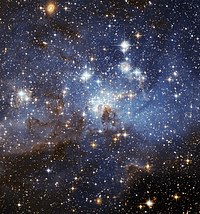Intergalaktisk rymdfart

Intergalaktisk rymdfart är rymdfart mellan galaxerna. På grund av de enorma avstånden skulle sådana resor kräva ännu mer teknisk utveckling än interstellära färder.
Tekniken ligger långt bortom den teknik människan har i dag, och är därför ännu bara föremål för science fiction och spekulation.[1][2] En av teorierna som föreslagits är användandet av så kallade maskhål.[3]
Källor
- Den här artikeln är helt eller delvis baserad på material från engelskspråkiga Wikipedia, Intergalactic travel, 14 september 2014.
Noter
- ^ Fogg, Martyn (1988). ”The Feasibility of Intergalactic Colonisation and its Relevance to SETI”. Journal of the British Interplanetary Society 41: sid. 491-496.. http://www.academia.edu/4166742/The_Feasibility_of_Intergalactic_Colonisation_and_its_Relevance_to_SETI.
- ^ Armstrong, Stuart; Sandberg, Anders. Eternity in six hours: intergalactic spreading of intelligent life and sharpening the Fermi paradox. Future of Humanity Institute, Philosophy Department, Oxford University.
- ^ ”När kan vi resa ut och besöka andra galaxer?”. Populär Astronomi. 15 januari 2000. http://illvet.se/universum/nar-kan-vi-resa-ut-och-besoka-andra-galaxer. Läst 14 september 2014.
Media som används på denna webbplats
MAVEN at Mars, Artist's Concept. This artist's concept depicts NASA's Mars Atmosphere and Volatile EvolutioN (MAVEN) spacecraft near Mars. MAVEN is in development for launch in 2013 and will be the first mission devoted to understanding the Martian upper atmosphere. The mission's principal investigator is Bruce Jakosky from the Laboratory for Atmospheric and Space Physics at the University of Colorado.
The goal of MAVEN is to determine the role that loss of atmospheric gas to space played in changing the Martian climate through time. MAVEN will determine how much of the Martian atmosphere has been lost over time by measuring the current rate of escape to space and gathering enough information about the relevant processes to allow extrapolation backward in time.
NASA Goddard Space Flight Center in Greenbelt, Md. manages the project and will also build some of the instruments for the mission. In addition to the principal investigator coming from CU-LASP, the university will provide science operations, build instruments, and lead education/public outreach. Lockheed Martin of Littleton, Colo., is building the spacecraft and will perform mission operations. The University of California-Berkeley Space Sciences Laboratory is also building instruments for the mission. NASA's Jet Propulsion Laboratory, Pasadena, Calif., will provide navigation support, the Deep Space Network, and the Electra telecommunications relay hardware and operations.
For more information about MAVEN, visit www.nasa.gov/maven.Kanadas flagga, införd 1965; denna version med Pantone‐nyanser. Nuvarande utformning ersatte den tidigare kanadensiska Red Ensign.
The Flag of Europe is the flag and emblem of the European Union (EU) and Council of Europe (CoE). It consists of a circle of 12 golden (yellow) stars on a blue background. It was created in 1955 by the CoE and adopted by the EU, then the European Communities, in the 1980s.
The CoE and EU are distinct in membership and nature. The CoE is a 47-member international organisation dealing with human rights and rule of law, while the EU is a quasi-federal union of 27 states focused on economic integration and political cooperation. Today, the flag is mostly associated with the latter.
It was the intention of the CoE that the flag should come to represent Europe as a whole, and since its adoption the membership of the CoE covers nearly the entire continent. This is why the EU adopted the same flag. The flag has been used to represent Europe in sporting events and as a pro-democracy banner outside the Union.bendera Indonesia
Flag of Iran. The tricolor flag was introduced in 1906, but after the Islamic Revolution of 1979 the Arabic words 'Allahu akbar' ('God is great'), written in the Kufic script of the Qur'an and repeated 22 times, were added to the red and green strips where they border the white central strip and in the middle is the emblem of Iran (which is a stylized Persian alphabet of the Arabic word Allah ("God")).
The official ISIRI standard (translation at FotW) gives two slightly different methods of construction for the flag: a compass-and-straightedge construction used for File:Flag of Iran (official).svg, and a "simplified" construction sheet with rational numbers used for this file.
Flag of Israel. Shows a Magen David (“Shield of David”) between two stripes. The Shield of David is a traditional Jewish symbol. The stripes symbolize a Jewish prayer shawl (tallit).
LH 95 stellar nursery in the Large Magellanic Cloud

























